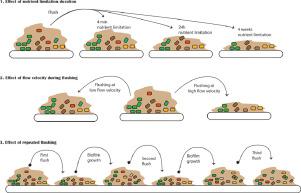Water Research ( IF 12.8 ) Pub Date : 2021-04-18 , DOI: 10.1016/j.watres.2021.117163 Hendrik J. de Vries , Eva Kleibusch , Gerben D.A. Hermes , Paula van den Brink , Caroline M. Plugge

|
Pure culture studies have shown that biofilm dispersal can be triggered if the nutrient supply is discontinued by stopping the flow. Stimulating biofilm dispersal in this manner would provide a sustainable manner to control unwanted biofilm growth in industrial settings, for instance on synthetic membranes used to purify water. The response of multispecies biofilms to nutrient limitation has not been thoroughly studied. To assess biomass dispersal during nutrient limitation it is common practise to flush the biofilm after a stop-period. Hence, flow-stop-induced biomass removal could occur as a response to nutrient limitation followed by mechanical removal due to biofilm flushing (e.g. biofilm detachment). Here, we investigated the feasibility to reduce membrane biofouling by stopping the flow and flushing the membrane. Using a membrane fouling simulator, biomass removal from synthetic membranes after different stop-periods was determined, as well as biomass removal at different cross flow velocities. Biomass removal from membrane surfaces depended on the nutrient limiting period and on the flow velocity during the biofilm flush. When flushed at a low flow velocity (0.1 m.s−1), the duration of the stop-period had a large effect on the biomass removal rate, but when the flow velocity was increased to 0.2 m.s−1, the length of the stop period became less considerable. The flow velocity during membrane flushing has an effect on the bacterial community that colonized the membranes afterwards. Repetition of the stop-period and biofilm flushing after three repetitive biofouling cycles led to a stable bacterial community. The increase in bacterial community stability coincided with a decrease in cleaning effectivity to restore membrane performance. This shows that membrane cleaning comes at the costs of a more stable bacterial community that is increasingly difficult to remove.
中文翻译:

生物污染控制:生物膜扩散和膜冲洗的影响
纯培养研究表明,如果通过停止流动而中断营养供应,则可以触发生物膜的扩散。以这种方式刺激生物膜的扩散将提供一种可持续的方式来控制工业环境中有害生物膜的生长,例如在用于净化水的合成膜上。多物种生物被膜对营养限制的反应还没有被彻底研究。为了评估养分限制期间的生物质扩散,通常的做法是在停药期后冲洗生物膜。因此,流动停止引起的生物质去除可能是由于对养分限制的响应,随后由于生物膜冲洗(例如生物膜分离)而被机械去除。在这里,我们研究了通过停止流动和冲洗膜来减少膜生物结垢的可行性。使用膜污染模拟器,确定在不同的停止时间后从合成膜中去除生物质,以及在不同的错流速度下去除生物质。从膜表面去除生物质取决于养分限制期和生物膜冲洗过程中的流速。以低流速(0.1毫秒)冲洗时-1),停止期间的持续时间对生物质去除率有很大影响,但是当流速增加到0.2 ms -1时,停止期间的长度变得不那么重要。膜冲洗过程中的流速对随后定居在膜上的细菌群落有影响。在三个重复的生物污损循环后,重复进行停止时间和生物膜冲洗,从而形成稳定的细菌群落。细菌群落稳定性的增加与清洁效率的降低相符,以恢复膜的性能。这表明膜清洁是以更稳定的细菌群落为代价的,而细菌群落越来越难以去除。



























 京公网安备 11010802027423号
京公网安备 11010802027423号